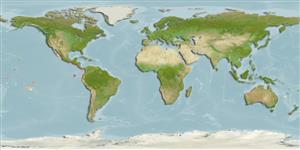Teleostei (teleosts) >
Eupercaria/misc (Various families in series Eupercaria) >
Haemulidae (Grunts) > Haemulinae
Etymology: Xenichthys: Greek, xenos = strange + Greek, ichthys = fish (Ref. 45335).
More on author: Gill.
Environment: milieu / climate zone / depth range / distribution range
Ecology
Marine; demersal. Tropical; 27°N -
Eastern Pacific: southern Gulf of California to Peru.
Size / Weight / Age
Maturity: Lm ? range ? - ? cm
Max length : 24.0 cm TL male/unsexed; (Ref. 55763); common length : 18.0 cm TL male/unsexed; (Ref. 55763)
Body oblong, fusiform, and somewhat compressed (its depth contained 2.7 to 3.0 times in standard length); mouth small, terminal, and oblique, its posterior end surpassing the anterior rim of the eye; lower jaw protruding; eyes very large; first gill arch with 22 to 26 gill rakers; dorsal fin deeply notched, with 12 spines and 17 to 19 soft rays (XII, 17-19); second anal spine shorter than third; back brownish green; flanks silvery with golden highlights and 5 or 6 golden yellow longitudinal stripes; upper edge of operculum with a dark spot; caudal peduncle with a dark spot (Ref. 55763).
Forms schools over sandy shallow bottoms (Ref. 9114).
Life cycle and mating behavior
Maturity | Reproduction | Spawning | Eggs | Fecundity | Larvae
Oviparous, distinct pairing during breeding (Ref. 205).
McKay, R.J. and M. Schneider, 1995. Haemulidae. Burros, corocoros, chulas, gallinazos, roncos. p. 1136-1173. In W. Fischer, F. Krupp, W. Schneider, C. Sommer, K.E. Carpenter and V. Niem (eds.) Guia FAO para Identification de Especies para lo Fines de la Pesca. Pacifico Centro-Oriental. 3 Vols. FAO, Rome. (Ref. 9114)
IUCN Red List Status (Ref. 130435)
Threat to humans
Harmless
Human uses
Fisheries: commercial
More information
ReferencesAquacultureAquaculture profileStrainsGeneticsElectrophoresesHeritabilityDiseasesProcessingNutrientsMass conversion
Tools
Special reports
Download XML
Internet sources
Estimates based on models
Preferred temperature (Ref.
123201): 23.1 - 29.1, mean 27.3 °C (based on 208 cells).
Phylogenetic diversity index (Ref.
82804): PD
50 = 0.6250 [Uniqueness, from 0.5 = low to 2.0 = high].
Bayesian length-weight: a=0.01288 (0.00750 - 0.02214), b=3.01 (2.86 - 3.16), in cm total length, based on LWR estimates for this species & (Sub)family-body (Ref.
93245).
Trophic level (Ref.
69278): 3.4 ±0.3 se; based on size and trophs of closest relatives
Resilience (Ref.
120179): Medium, minimum population doubling time 1.4 - 4.4 years (Preliminary K or Fecundity.).
Fishing Vulnerability (Ref.
59153): Low vulnerability (14 of 100).
Nutrients (Ref.
124155): Calcium = 199 [41, 420] mg/100g; Iron = 1.25 [0.63, 2.49] mg/100g; Protein = 18.5 [16.6, 20.4] %; Omega3 = 0.218 [0.110, 0.395] g/100g; Selenium = 35.9 [19.6, 70.1] μg/100g; VitaminA = 27.6 [10.9, 69.2] μg/100g; Zinc = 1.35 [0.94, 1.94] mg/100g (wet weight);
